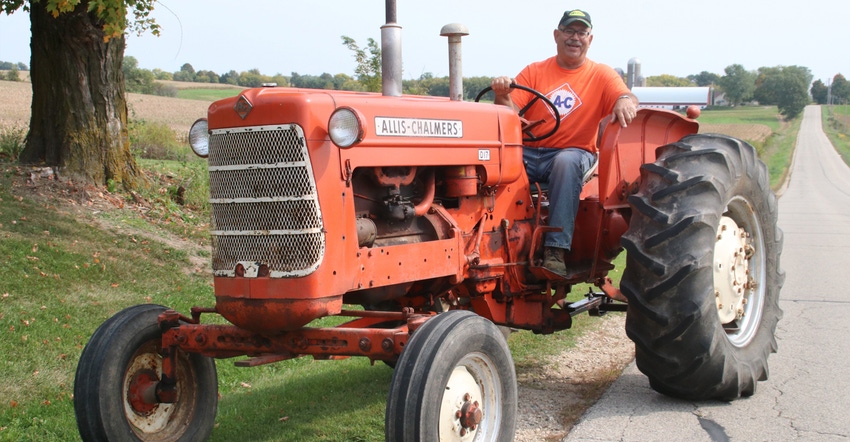July 19, 2021

Jim Klink from Rubicon was 13 years old when his father, Lester, purchased a used model 1958 Allis-Chalmers D17 Series tractor with 400 hours from a local farmer-dealer who owned Persha Implement in Mayville, Wis.
At that time, Lester was farming with an Allis-Chalmers WD45. But after buying an additional 100 acres to raise more corn, oats, hay, peas and red beets, he needed a bigger machine for his Dodge County farm. So, the WD45 and a three-bottom, 14-inch moldboard plow were traded in for the D17 and a three-bottom, 16-inch plow.
The tractor was also used on the 12-foot snap-coupler field cultivator to chop hay and corn with a Gehl 83 forage harvester and a four-row John Deere 494 planter. Normally, it averaged 150 to 200 hours of work time in the fields each summer.
Old friend
As a teenager, Jim spent many days on the tractor seat. He recalls that the dry mechanical band brakes on the D17 were lousy. They had to be adjusted several times, and the linings, especially on the left side, needed to be replaced fairly often due to excessive wear while plowing.
This row-crop tractor had a hand-operated, shift-on-the-go oil clutch. Allis-Chalmers marketed this arrangement as the “Power Director,” or according to Jim, “The Big Stick.” When placed in neutral, it allowed the PTO to continue operating and provided a high and low ground speed.
The D17 weighed 4,470 pounds, and 65,540 units were manufactured from 1957 to1967 in West Allis, Wis. The listed price in 1967 was $5,400. Other features included manual steering, wide front end, toolbox on the right fender, eight forward and two reverse gears, and a 3.7-liter, four-cylinder, liquid-cooled, vertical gasoline engine.
Little maintenance was required on the D17. The engine was overhauled once in the 1970s, which entailed new piston rings and valves. The original frame was repainted, but the wheels were changed to a cream color to match the newer Series III D17.
After attending General Motors Institute, an engineering college in Flint, Mich., and working for his father for a couple of years, Jim in 1977 went into partnership with Lester on the 300-acre operation. Now retired, Jim’s son, Ben, the sixth generation on the original land that was deeded in 1879, handles a total of 1,200 acres.
“The D17 was a good-running, easy-to-start tractor. It rarely sat idle in the shed. Even today, it operates the 51-foot, 10-inch grain auger,” Jim says. “I wash and clean the body, and take it to parades and field days sponsored by the Restored Antique Tractor Club.”
“A few years ago, I purchased a 1947 Allis-Chalmers All Crop 60 combine with a 5-foot sickle head and apron similar to the one Dad owned,” Jim says. “During wheat harvest, Ben leaves a 30-foot swath for 1,000 feet across the field. What Ben could have harvested in about five minutes took an hour to do with the old All Crop.
“My three oldest grandsons — Josh, 17, Jay, 16, and Ethan, 14 — were able to drive the Case D17 on the combine, while I ran alongside with the video camera,” Jim adds. “Seeing the joy and those smiles while operating their great-grandfather’s tractor is priceless.”
Persinger writes from Milwaukee. To have your favorite tractor featured, email or send in a photo of yourself with your tractor, along with a 300-word write-up about the tractor to [email protected], or Wisconsin Agriculturist, P.O. Box 236, Brandon, WI 53919.
About the Author(s)
You May Also Like




